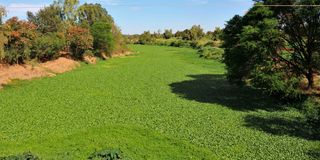Water hyacinth chokes River Athi, hits livelihoods

Water hyacinth covers section of River Athi passing through Kabaa area in Machakos County. The invasive weed which has covered kilometres of the river.
A green carpet greets motorists crossing the section of River Athi which passes through Kabaa area in Machakos County.
Water hyacinth, an aquatic weed, has covered the entire water channel creating a solid greenery.
From the bridge, the water hyacinth menace extends outwards on both sides to as far as the eyes can see to the chagrin of the riparian community.
Save for clogging of the points of drawing water, farmers said, the weed has not affected farming in the region in a significant way. However, it has hampered fishing, an important economic activity in the region.
“To catch fish we are forced to travel many kilometres downstream where the density of the floating weed is low,” said Peter Kilonzi, a fisherman in the area.
Also Read: Lake Victoria's sorry state
Kiaoni, a vibrant trading centre along the river, is the most hit by the water hyacinth menace. The Nation established that the cost of fish in the market has tripled since August. Yet many of the fishmongers in the shopping centre have closed shop citing dwindling incomes.
Invasive weed
The invasive plant which is native to South America has been spreading rapidly across the world.
Around Lake Victoria where the weed has clogged the shores, local communities have learned to coexist with it. They ‘harvest’ the weed and turn it into useful products such as bio-fuels and fertilizers.
But in Machakos County the weed still remains strange. Administrators in the affected regions have stepped up a campaign against swimming in the river lest the swimmers get entangled in the invasive weed.
“We are used to small patches of water hyacinth which easily wash away when it rains. This year, however, the floating weed has spread to unprecedented levels. It is a safety hazard,” said Kabaa Assistant Chief Rosina Munyao.
According to Professor Gideon Nyamasyo, a former University of Nairobi environmental studies lecturer who has studied the invasion of water hyacinth in other water bodies, the invasive species is a pointer to contamination of the river which supports millions of livelihoods in the semi-arid Ukambani and beyond.
“Water hyacinth thrives in a polluted aquatic environment. The concentration of the weed in a section of a river shows that farmers in the region are using a lot of fertilizer which washes into the river when it rains,” he told the Nation in an interview.
He, however, played down the impacts of the weed on the river ecosystem.
“The weed is useful as a bio cleaner of water bodies. Water hyacinth is known to clean away some of the heavy metals contained in water bodies such as rivers. Water hyacinth easily dies off and washes away when it is exposed to clean water,” he added.
Cleaning River Athi
The water hyacinth invasion has renewed push by locals to clean River Athi.
Machakos Governor Wavinya Ndeti has pledged to lead from the front in cleaning up the permanent river which starts in Kiambu County and whose tributaries include Nairobi River.
“We have already initiated talks with the national government as well as Kajiado, Kiambu and Nairobi county governments which are jointly responsible for discharging effluents into River Athi so as to reverse the trend and clean up the important river,” she said recently.
Scientists have shown that the river is contaminated with dangerous toxins and heavy metals discharged from factories.
Last year, President Uhuru Kenyatta pledged the government’s commitment to clean-up of the river following outcries over its pollution which had been raised by the Auditor General, environmentalists, local leaders and the riparian communities.





